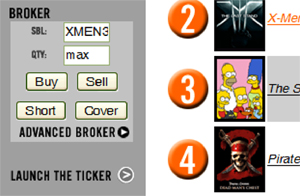Wisdom of Crowds: How Prediction Markets Work
How to let ordinary people make wise predictions for you better than experts.
The Wisdom of Crowds by James Surowiecki digs into that phrase and gives excellent examples of how it can be used on the web. I wrote about it earlier after hearing James Surowiecki on MP3 from SxSW.
Two weeks ago, Boxes and Arrows (online magazine for information architecture) got into one of the gory details: Prediction markets. Surowiecki’s point is that prediction markets are more accurate than the prediction of experts. For instance, HP employees can bet on what they think product sales will be, and they’re better than HP’s internal predictions 3 out of four times.
From Alex Kirtland’s article on Boxes and Arrows about prediction markets:
[Prediction markets] need to make themselves relevant, attract the right types of traders, and teach people who are new to trading how to trade.
Several websites have taken on this daunting task with mixed success. These public prediction markets offer markets and contracts that cover a range of issues and events. They each have different functionality, and have designed their markets in different ways, but all are trying to solve the same problem: how to engage users to participate in these markets, and produce meaningful predictions.
What follows are some basic and general rules, gleaned from audits of these sites (with selected examples to help explain), about how to improve the communication and simplification of complex ideas about trading, and how to engage users, particularly when developing a prediction market.
Alex has lots of good examples in his in-depth review of several prediction markets/websites. Apart from Hollywood Stock Exchange (that Surowiecki also covers), there are examples such as Trendio, ProTrade, HSX, Smarkets, Inkling, CrowdIQ, NewsFutures, Yahoo! Tech Buzz Game and more.
The Boxes and Arrows article is also focused on what works in the user interface, which makes it an extremely valuable article.
HSX Trading WidgetThe HSX trading widget is even simpler and allows for even greater flexibility. Mouse over the movie you want to buy and the widget pre-populates. Max quantity allows you to purchase the maximum allowed amount. If you already own shares in this movie, to sell all of them just sell max, and you never have to worry about remembering how many shares you already own.
Link to Alex Kirtland’s article on Boxes and Arrows about prediction markets
Link to my previous post “Wisdom of Crowds” with podcast MP3
Technorati Tags: james surowiecki, wisdom of crowds, psychology, prediction markets


November 28th, 2006 at 17:33 (GMT-1)
[…] This reminds me of some of the examples from James Surowiecki’s Wisdom of Crowds: How Prediction Markets Work. Especially the example from Eli Lily where the crowd bets on which products make it through clinical testing. […]
March 23rd, 2007 at 20:31 (GMT-1)
Richard McManus has a new interesting article on this subject
Crowdsourcing: A Million Heads is Better than One
Lots of good examples on projects and startups.
June 26th, 2007 at 17:12 (GMT-1)
Just to let you know TV 2 is doing their own prediction market called Nyhedsspillet. (nyhedsspil.tv2.dk) It is developed by the danish prediction market company Nosco (www.nosco.dk)
Regards Oliver